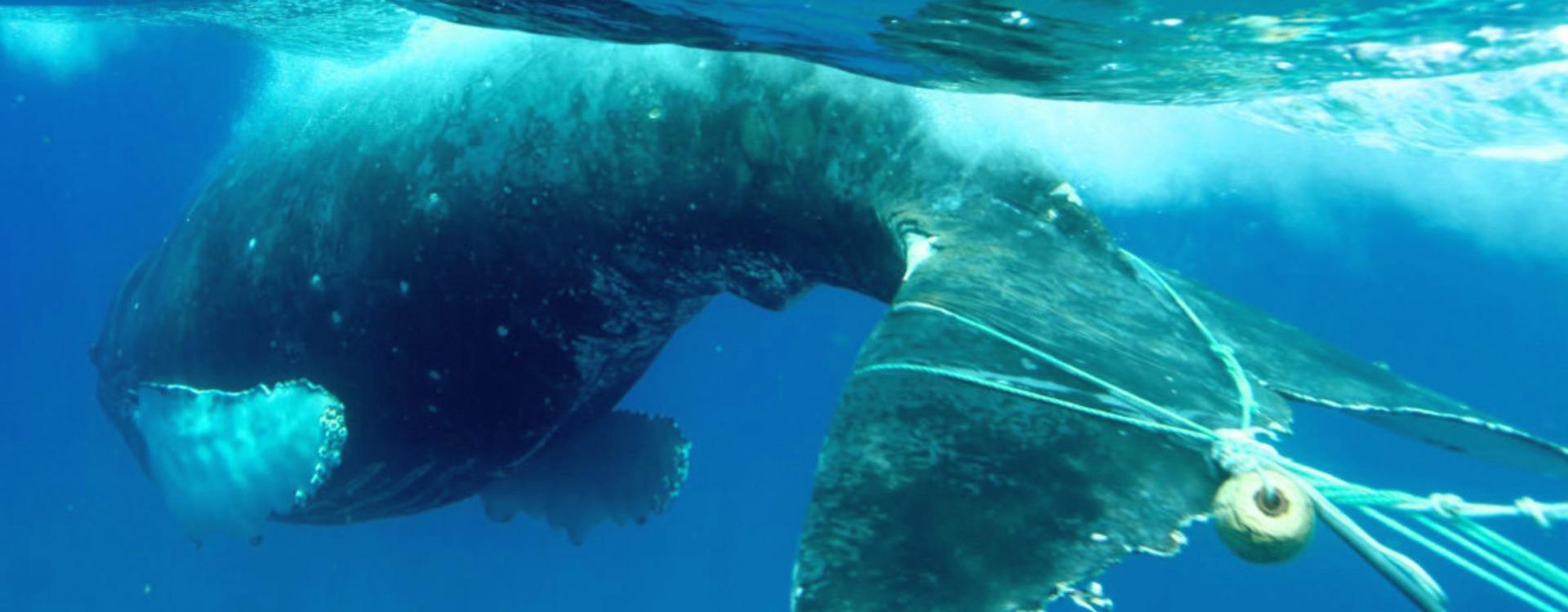
Less gear in the water means fewer chances for Whales to become entangled. Photo Credit: E. Lyman/ NOAA Sanctuaries
Sometimes simple solutions are better. It all depends on the nature of the problem. For humpback whales, the problem is the rope connecting a crab trap on the seafloor to the buoy on the surface. And for fishermen, it’s fishery closures caused by whale entanglements.
Managing this issue is currently a major item on California’s agenda, and it appears less fishing gear may be the optimal solution. So says a team of researchers led by Christopher Free, at UC Santa Barbara, after modeling the benefits and impacts that several management strategies would have on whales and fishermen. Their results, published in the journal Biological Conservation, find that simply reducing the amount of gear in the water is more effective than dynamic approaches involving real-time monitoring of whale populations.
“We were trying to figure out what types of management strategies would work best at reducing whale entanglements in the Dungeness crab fishery while also minimizing impacts to fishing,” said first author Free, a researcher at the university’s Marine Science Institute. “And what we found is that some of the simpler strategies, such as just reducing the amount of gear allocated to the fishermen, outperformed a lot of the more complex management strategies.”
Free and his colleagues created a computer model to investigate different management actions based on crab abundance, fisherman behavior and whale behavior. The model predicts how a given approach will affect total catch as well as the frequency with which whales encounter traps. Strategies included gear reductions and closures triggered by surveys, entanglements or time of year. The authors judged each action based on how well it reduced entanglement risk, while minimizing disruptions to the fishing season and total landings.
A 30% reduction emerged as the optimal course of action.
Free has several explanations for these findings. First and foremost, reducing the amount of gear directly addresses the problem: the number of lines in the water for whales to get entangled in. Dynamic closures merely move these lines around. Static strategies also don’t rely on surveys or monitoring efforts which can be inconsistent, irregular and expensive.
In contrast, static strategies are cheap and predictable. They require no costly equipment, and don’t introduce any uncertainty into the fishing season or fishing grounds. The Dungeness crab fishery is a derby fishery, characterized by intense fishing effort early on. The abundance of crabs means that fishermen can still make good catches in those early weeks even with fewer traps. Indeed, most of the catch is landed early in the season.
According to Free, the fishery regularly catches 90% of male crabs in a season, yet simple management measures have maintained a sustainable and profitable fishery. Fishermen can only keep males above a certain size during a certain season. This ensures that young crabs can grow up, females can lay eggs, and the studs can fertilize the next generation. Turns out that the crab population is not limited for want of males.
But what was once the easiest fishery to manage is now among the hardest. Climate change has shifted whale foraging ground inshore — intensifying the overlap with fishing — and made toxic algae blooms more common — which can delay the opening of the season due to health risks. For instance, a severe algae bloom in 2015 delayed the opening until April, precisely when humpbacks are headed north to their summer feeding grounds. This caused a huge spike in entanglements, and the Center for Biological Diversity sued California for failing to comply with the Endangered Species Act and Marine Mammal Protection Act. The state settled, and there’s since been a rush to overhaul the fishery’s management plan.
To that end, the researchers developed a tool that enables policy-makers and regulators to test any management strategy they can think of, including ones the authors didn’t consider. Models such as this one are crucial for these sorts of questions, where it’s impractical, unethical or impossible to run an experiment.
One shortcoming of this model is that it aggregates all fishermen together, despite significant differences between them. For instance, some fishermen switch to different species after the initial boom, while others continue to focus on crabs. Vessel size, geography and license type all matter as well. It will take more research to understand how regulatory impacts distribute among different fishermen.
Free plans to investigate how to minimize the impact of toxic algae blooms on the fishery. Dynamic strategies actually show much more promise for tackling this issue. He’d like to design a more precise algae monitoring system so that closures are limited to just what is essential for protecting public health. Clearly, there’s still much to learn about what makes an issue more amenable to static or adaptive management strategies.